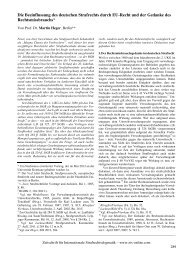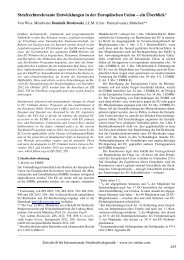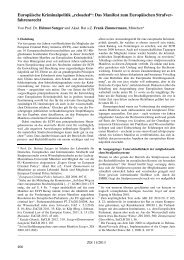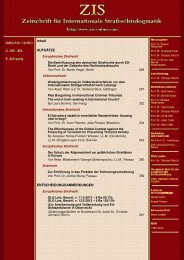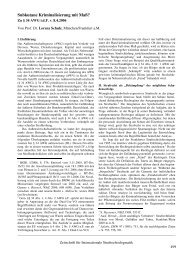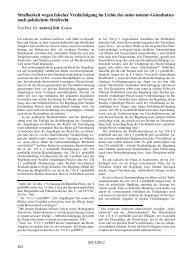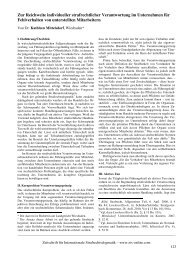Inhalt AUFSÄTZE ANHANG - ZIS
Inhalt AUFSÄTZE ANHANG - ZIS
Inhalt AUFSÄTZE ANHANG - ZIS
- No tags were found...
You also want an ePaper? Increase the reach of your titles
YUMPU automatically turns print PDFs into web optimized ePapers that Google loves.
Harmen van der Wilt_____________________________________________________________________________________For Ambos, it is self-evident that Organisationsherrschaftmeets these required standards: “In fact, unlike JCE, it finds alegal basis in the term ‘committed’ in Article 7(1) ICTYStatute, since ‘commission’ in this sense means that a person‘participated, physically or otherwise directly or indirectly, inthe material elements of the crime charged through positiveacts or, based on a duty to act, omissions, whether individuallyor jointly with others’. This includes, as indirect commission,perpetration by means and as such Organisationsherrschaft.”(emphasisin original) 35In a similar vein, one might argue – and perhaps evenmore convincingly – that Article 25, s. 3 (a) of the RomeStatute, at least implicitly, encompasses Organisationsherrschaft,as this provision includes ‘perpetration through anotherperson’ under the definition of ‘commission’.The interesting question was whether Trial Chambers ofthe International Criminal Court would be prepared to expand‘perpetration through another person’ to cover ‘commissionby means of an organisation’ as well. Recent case law of thePre Trial Chambers revealed that they were indeed susceptibleto the possibilities of Organisationsherrschaft.36 The Pre-Trial Chamber had explored the concept for the first time inLubanga, but had ultimately opted for ‘co-perpetration’. 37However, in the Katanga-case, the Pre Trial Chamber embracedand applied the doctrine whole-heartedly. It explicitlyacknowledged that the most serious international crimesalmost inevitably concerned collective or mass criminality.And it added that “prior and subsequent to the drafting of theStatute, numerous national jurisdictions relied on the conceptof perpetration through control over an organization in orderto attribute principal responsibility to ‘leaders’ in respect ofthose crimes.” 38censured the Trial Chamber for employing co-perpetration, amode of liability which it considered no valid law within thejurisdiction of the Tribunal (§ 62).35 Ambos, Joint Criminal Enterprise and Command Responsibility,in: Journal of International Criminal Justice 5 (2007),182 and Ambos (Fn. 23), pp. 143 (144).36 Pre-Trial Chamber I, Decision on the Confirmation ofCharges, Lubanga, ICC-01/04-01/06, 29. January 2007,§§ 327-367; Pre Trial Chamber I, Decision on the Confirmationof Charges, Katanga and Chui, ICC-01/04-01/07,30. September 2008, §§ 477-518; Pre Trial Chamber III,Warrant of Arrest for Jean Pierre Bemba Gombo Replacingthe Warrant of Arrest of 23 May 2008, ICC-01/05-01/08,10. June 2008, §§ 21-24 and Pre Trial Chamber I, Decisionon the Prosecution’s Application for a Warrant of Arrestagainst Omar Hassan Ahmad Al Bashir, ICC-02/05 – 01/09,4. March 2009, §§ 209-223.37 Lubanga (Fn. 36), §§ 94-96. For a careful comment onsubstantive law aspects of the case, including Organisationsherrschaftand co-perpetration, see: Weigend, Intent, Mistakeof Law, and Co-perpetration in the Lubanga Decision onConfirmation of Charges, Journal of International CriminalJustice (2008), 471-487.38 Katanga and Chui (Fn. 36), § 502.The Pre Trial Chamber painlessly followed suit: “In sum,the acceptance of the notion of ‘control over an organizedapparatus of power’ in modern legal doctrine, its recognitionin national jurisdictions, its discussion in the jurisprudence ofthe ad hoc tribunals which, as demonstrated, should be distinguishedfrom its application before this Court, its endorsementin the jurisprudence of the Pre Trial Chamber IIIof the International Criminal Court but, most importantly, itsincorporation into the legal framework of the Court, present acompelling case for the Chamber’s allowing this approach tocriminal liability for the purposes of this Decision.” 39Abundantly quoting Roxin and other – German and LatinAmerican – leading scholars in criminal law, the Pre TrialChamber discussed the several – objective and subjective –elements of the doctrine. Prompted by the specific circumstancesof the case, the Chamber managed to introduce somecreative solutions. First, it applied simultaneously the conceptsof indirect perpetration (Organisationsherrschaft) andco-perpetration. Katanga and Chui exercised a large measureof control over their respective contingents of child soldiers,based on ethnical affiliations. However, they wielded noabsolute power over the other’s organization, as some membersaccepted only orders from leaders of their own ethnicity.40 As they could only accomplish their goal – the attack ofan unprotected village – by joining forces and they realizedthat they were mutually dependent on the mobilization andassistance of each other’s loyal supporters, they could bequalified as ‘co-perpetrators’. The Chamber forged a constructionwith a horizontal and a vertical component: “[…]through a combination of individual responsibility for committingcrimes through other persons together with the mutualattribution among the co-perpetrators at the senior level,a mode of liability arises which allows the Court to assess theblameworthiness of ‘senior leaders’ adequately.” 41 Obviously,this approach calls to mind the discussion on the juxtapositionof concepts in the previous section.Secondly, the Chamber has recognized that the originalrequirements of Organisationsherrschaft – like the elementthat the physical perpetrators should be replaceable – bear theseal of the modern bureaucracy paradigm from which it derives.The Chamber has acknowledged that automatic compliancewith the leader’s orders may be accomplished byother means than through the fungibility of subordinates: “Analternative means by which a leader secures automatic compliancevia his control of the apparatus may be through intensive,strict and violent training regimes. For example, abductingminors and subjecting them to punishing training regimensin which they are taught to shoot, pillage, rape and kill,may be an effective means for automatic compliance withleaders’ orders to commit such acts.” Such a flexible approach,geared to the specific circumstances, may prove theversatility of the concept and its resilience against the wearand tear of time.39 Ibidem, § 510.40 Katanga and Chui (Fn. 36), § 493.41 Ibidem, § 492.42 Katanga and Chui (Fn. 36), § 518._____________________________________________________________________________________42620<strong>ZIS</strong> 11/2009




